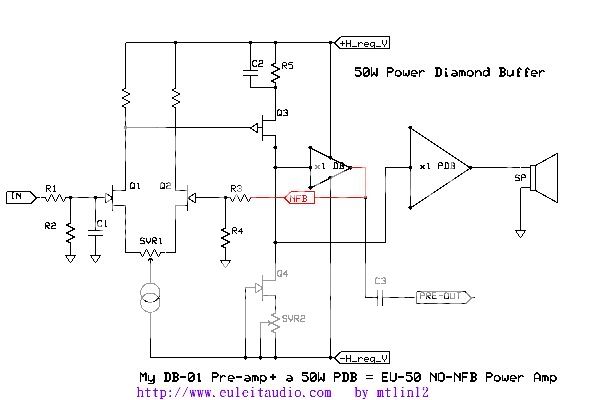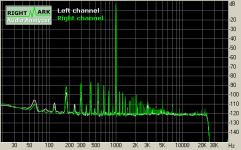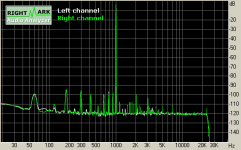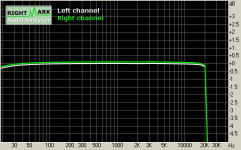I built my DB-01 pre-amp few years ago, and I also built a 25W
0dB Power Diamond Buffer Amp two years ago.
http://www.diyaudio.com/forums/showthread.php?s=&threadid=54408&perpage=10&pagenumber=4
Recently I want to combine the pre-amp and a new thermaltrack PDB circuit
to build another 50W non-total NFB amp, but I found this article:
Comparing my pre-amp + the thermaL_track PDB, they are almost
the same, so should I call it another "SPLIF" ( SPLIT FEEDBACK ) AMP?
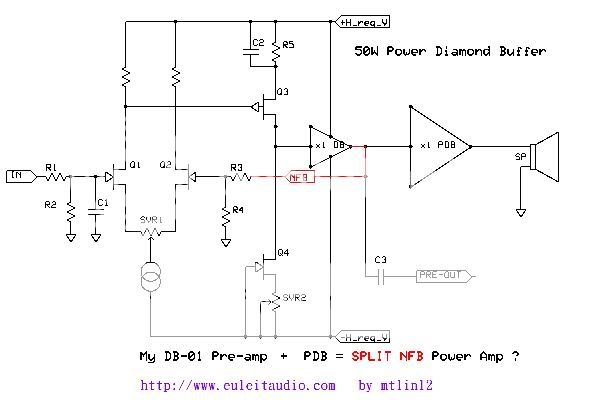

0dB Power Diamond Buffer Amp two years ago.
http://www.diyaudio.com/forums/showthread.php?s=&threadid=54408&perpage=10&pagenumber=4
Recently I want to combine the pre-amp and a new thermaltrack PDB circuit
to build another 50W non-total NFB amp, but I found this article:
Is there anybody built a non feedback amplifier?? post #11rbroer said:You might consider this:
http://www.altmann.haan.de/splif_page/#the feedback
(The ALTMANN "SPLIF" Amplifier Topology)
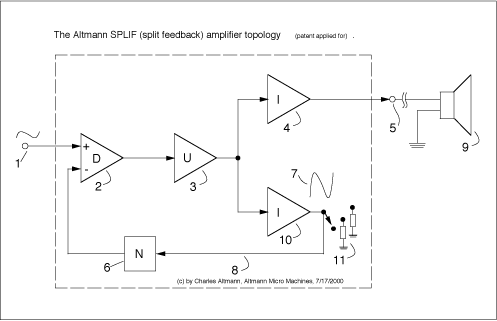
Comparing my pre-amp + the thermaL_track PDB, they are almost
the same, so should I call it another "SPLIF" ( SPLIT FEEDBACK ) AMP?


Hi MTlin,
Congratulations on your amp completion
How does it sound, does it have a specific sonic signature...
What about the low frequency response with this amp, whats the damping factor you obtained, does it fairly controls the speaker cone movement...
regards,
K a n w a r
Congratulations on your amp completion
How does it sound, does it have a specific sonic signature...
What about the low frequency response with this amp, whats the damping factor you obtained, does it fairly controls the speaker cone movement...
regards,
K a n w a r
hi mtlin12,
I'll jump in, I can't see any resemblance to the SPLIF. My understanding of SPLIF is it requires parallel output devices. One of the output pairs drives a ideal dummy load and this is used as feedback for the differential pair. The rest of the output devices drives the speakers as per normal. The idea is to avoid the distortion generated by driving the speakers from being in the feedback circuit.
Or I could be completely wrong.
regards
I'll jump in, I can't see any resemblance to the SPLIF. My understanding of SPLIF is it requires parallel output devices. One of the output pairs drives a ideal dummy load and this is used as feedback for the differential pair. The rest of the output devices drives the speakers as per normal. The idea is to avoid the distortion generated by driving the speakers from being in the feedback circuit.
Or I could be completely wrong.
regards
Hi Kanwar,
Long time no see,
Yesterday I brought my pre-amp and power-amp to a second-handed
audio store, tested with the Platinum Audio's trio a 4 OHM 86dB/W
loudspeaker which I was told being designed by Phil Jones.


I'm glad to tell you that all my friends love its sound. Fast speed,
powerful, low noise, low distortion, transparent, very detailed and live...
It is pure DC-coupling design, the offset and thermal problem are
very little, wide F.R. range around 0~500KHz -3dB, only the damping
factor I think is not very high, I guess not even 40.

Long time no see,
Yesterday I brought my pre-amp and power-amp to a second-handed
audio store, tested with the Platinum Audio's trio a 4 OHM 86dB/W
loudspeaker which I was told being designed by Phil Jones.


I'm glad to tell you that all my friends love its sound. Fast speed,
powerful, low noise, low distortion, transparent, very detailed and live...
It is pure DC-coupling design, the offset and thermal problem are
very little, wide F.R. range around 0~500KHz -3dB, only the damping
factor I think is not very high, I guess not even 40.
Greg Erskine said:hi mtlin12,
I'll jump in, I can't see any resemblance to the SPLIF. My understanding of SPLIF is it requires parallel output devices. One of the output pairs drives a ideal dummy load and this is used as feedback for the differential pair. The rest of the output devices drives the speakers as per normal. The idea is to avoid the distortion generated by driving the speakers from being in the feedback circuit.
Or I could be completely wrong.
regards
thank you Greg,
Yes, I know the SPLIF output devices should be paralleled, so My
second posted circuit topology is just as you mentioned, the DB
( my pre and headphone amp driver) does parallel with the 50W
x1 PDB (Power Diamond Buffer ).
And only the pre-amp ( with no load ) has split NFB, the PDB doesn't feedback any harmful signals.
The PDB can be just one or several output devices.
The reason I use this pre-amp with PDB is because there already
has a good quality high voltage shunt regulator on my EU-01 (as driver) PCB.
Hi Mtlin
I think your current amplification is very less[you might be using only double darlington EF stage]....
If you need higher damping than atleast use triple or Quad Emitter Follower Pipeline or use Mosfets which would enable even much higher damping factor....
K a n w a r
I think your current amplification is very less[you might be using only double darlington EF stage]....
If you need higher damping than atleast use triple or Quad Emitter Follower Pipeline or use Mosfets which would enable even much higher damping factor....
K a n w a r
Actually I use triple darlington this time, 2N5401/5551, 2SB649A/2SD669A and of course
my favorite BJT SANKEN 2SA1216/2SC2922, so I think the current
gain would be no problem, my only concern is that I am not dare
to use lower than 0.1 OHM emitter resistor because every 0.01V
rise will cause 100mA stand-by current up.
This 0.1 OHM maybe the most problem of damping factor.

my favorite BJT SANKEN 2SA1216/2SC2922, so I think the current
gain would be no problem, my only concern is that I am not dare
to use lower than 0.1 OHM emitter resistor because every 0.01V
rise will cause 100mA stand-by current up.
This 0.1 OHM maybe the most problem of damping factor.
I had another circuit topology and power amp prototype made
last year, it was NFB from the 2nd VAS stage, not through the
headphone DB nor the Power DB, only it has no driver stage
voltage regulaor, but still sounds very clear tested with 107dB
KLIPSCH "Klipschorn Anniversary" which belongs to my friend.
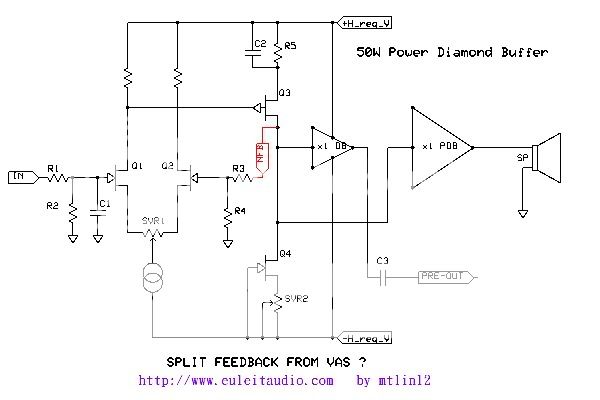

last year, it was NFB from the 2nd VAS stage, not through the
headphone DB nor the Power DB, only it has no driver stage
voltage regulaor, but still sounds very clear tested with 107dB
KLIPSCH "Klipschorn Anniversary" which belongs to my friend.


mtlin12 said:Actually I use triple darlington this time, 2N5401/5551, 2SB649A/2SD669A and of course
my favorite BJT SANKEN 2SA1216/2SC2922, so I think the current
gain would be no problem, my only concern is that I am not dare
to use lower than 0.1 OHM emitter resistor because every 0.01V
rise will cause 100mA stand-by current up.
This 0.1 OHM maybe the most problem of damping factor.

You cannot go lower than 0.1ohm...
You can parallel more output transistors as well, or go for Quad EF
You can also try mosfets as they can provide more damping..
What about the bass performance of this amp
No, I haven't and no time to test the Power AMP, only pre-amp
NFB with a Diamond Buffer has been test by SB X-Fi and RMAA5.5.
http://www.euleitaudio.com/tw/EU-01-test.htm
NFB with a Diamond Buffer has been test by SB X-Fi and RMAA5.5.
http://www.euleitaudio.com/tw/EU-01-test.htm
Workhorse said:
You cannot go lower than 0.1ohm...
You can parallel more output transistors as well, or go for Quad EF
You can also try mosfets as they can provide more damping..
What about the bass performance of this amp
If I use this structure to make a new 150W, I will parallel more
output transistors, but 50W I think one pair of SANKEN is enough.
4 years ago I alreay designed a 150W NFB MOSFET AMP ULTIMA-1.
The bass performance is really good and fast, we used Wilson
Audiophile's "WINDS of WAR and PEACE" CD test the drum and
seems pretty good. I think 80,000uF/50V does work fine for the bass.
bikehorn said:so what happens when you let the smoke out of a SPLIF amp?
My question is if I just feedback from VAS and eliminate the DB
of the pre-amp than it will not become a "SPLIF" amp?
Because it has no parallel output buffer?
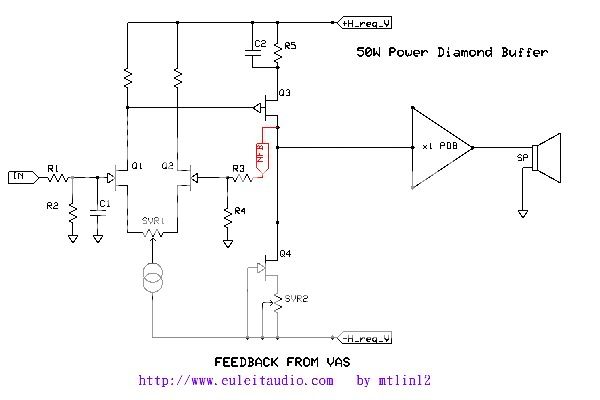
Pasul said:Do you have any picture of THD distortion of this amp?I like to see it.THX
I tested the THD distortion output from PDB without NFB and any load,
( just as a line loopback ). I can't borrow my friend's AP2 tester
this time, so I used SB X-Fi card and RMAA5.5 to test the amp.
The THD picture is as attachment:
Parameter Left Right
THD, %: 0.0016 0.0019
THD + Noise, %: 0.0111 0.0154
THD + Noise (A-weighted), %: 0.0093 0.0121
Attachments
Another picture is the THD of the amp's driver:
I tested the THD distortion output from DB of the driver with NFB ,
( also as a line loopback withou loading).
Again I used SB X-Fi card and RMAA5.5 to test the amp.
The THD picture is as attachment:
Parameter Left Right
THD, %: 0.0019 0.0022
THD + Noise, %: 0.0095 0.0092
THD + Noise (A-weighted), %: 0.0081 0.0080
I tested the THD distortion output from DB of the driver with NFB ,
( also as a line loopback withou loading).
Again I used SB X-Fi card and RMAA5.5 to test the amp.
The THD picture is as attachment:
Parameter Left Right
THD, %: 0.0019 0.0022
THD + Noise, %: 0.0095 0.0092
THD + Noise (A-weighted), %: 0.0081 0.0080
Attachments
Workhorse said:Hi Mtlin,
What about the sound quality of your amp, i mean to say bass, speaker cone movement control, mid resolution and treble details...I am also doing similar to this but with all N-channel mosfets...
regards,
Kanwar
Hi Kanwar,
I'm glad to tell you that this amp ( or SPLIF topology) is really good.
I can't describe how good is the sounding, but I can tell you its
frequency response is almost flat ( 20 Hz to 20 kHz, dB -0.27, +0.01 )
just like a DC coupling pre-amp.
"Fast speed, powerful, low noise, low distortion, transparent, very detailed and live..."
my friends described last time tested with Phil Jones' Platinum Audio trio.
Though they asked for an AB TEST between SPLIF and global NFB,
they wanted to know the bass can be improved or not, but we didn't have enough time.
Attachments
- Status
- This old topic is closed. If you want to reopen this topic, contact a moderator using the "Report Post" button.
- Home
- Amplifiers
- Solid State
- Should I call this pre-amp+ PDB a "SPLIF" Amp?

